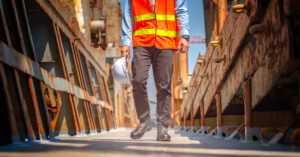It is a warm summer day. At the construction site, the work goes on at its normal pace. Suddenly, the management gets a call that a worker has fallen from a height and lies immobile, face down. Managers and OHS services arrived to the incident location immediately. An ambulance came and provided aid to the worker, who complained of terrible pain in his back. He was taken to a hospital.
What did happen here?
Workers were dismantling a platform near one of railway tracks. At one time, a small platform shed was to be removed. The workers reported that a scaffolding was required to dismantle a glass roof of that shed, but on that particular day they had not taken it from the depot and they decided to improvise. They stacked some pallets and conducted demolishing works from it. The injured worker climbed onto the roof, and from that position unscrewed fixtures of the glass pane, on which he sat, and this resulted in the accident.
One of the Works Managers decided to check out the monitoring. The camera recorded the incident and a worrying detail was discovered, which could shed new light on that accident. Next day, the witnesses came to a conference room. When asked about the course of the events, they confirmed their initial version, that the injured worker had climbed on the roof and fell from it. Then, the Construction Site Manager asked them whether there was an excavator near the shed. Its operator sighed and asked: you have the recordings, don’t you?
It turned out that the stack of pallets proved to be too low.
After some thinking, the injured worker climbed into the excavator bucket that lifted him to the level of the shed roof to perform dismantling works. Everything would be fine, but the excavator rotated suddenly, and he fell out of it. How was it possible?’ Another worker entered the excavator, to take a hammer from it. By accident, he moved a control rod, and that was a cause of the sudden movement of the excavator, and the accident itself. If the recordings had not been available, nobody would have learnt the real course of events. The recordings were made by cameras of very high quality, so not only it was possible to reconstruct the events, but also to identify all their participants.
Each construction site is a place where similar incidents occur. Fortunately, the majority of them ends with minor injuries. Unfortunately, frequently everything remains undiscovered because nobody wants to be held responsible. To avoid situations of this type and ensure safety at work at the construction site, you must use visual monitoring of high quality, and with an easy access to recordings. As every incident is recorded, you will smoothly reconstruct and establish the actual course of it and people responsible for its occurrence. When they know about this, construction site workers adhere to OHS regulations to a greater extent and avoid risky behaviours.
The modern technology enables tracking of the working time and the course of the entire employee’s activity at the construction site, from the moment of entering to the moment of leaving it. This greatly facilitates the work of the Inspector, who now can view up to 30 construction sites at the same time. With modern cameras, they can magnify even 25 times each incident and workers without a helmet or a vest. Suddenly, workers cannot “prepare” for the inspector’s visit because they monitor them without any warning.
This is supplemented by an innovative service in form of a construction site video logbook, with which you can review the entire working day, check the progress and a material flow in just 2 minutes. You know who did, brought in or took away what, and what were conditions at the construction site during work; this can be of importance, e.g., during pouring out of concrete in wrong conditions, providing you with evidence in the event of a complaint. With modern visual monitoring systems you can be sure that nothing escapes you or occurs without you knowing about it.
You can call or write to us, we will answer every inquiry.










